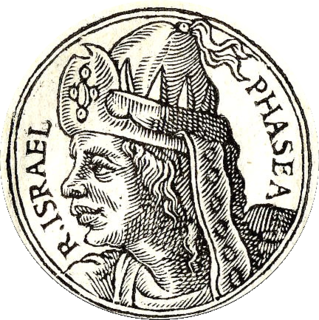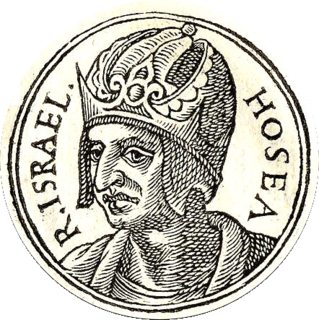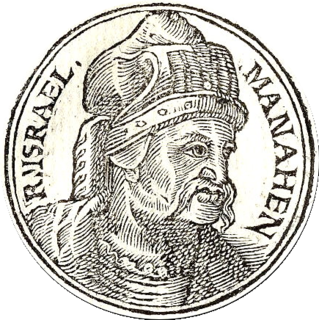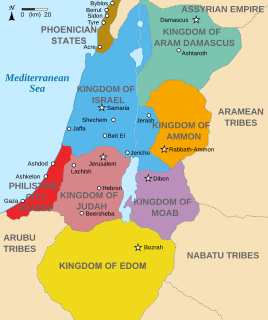Related Research Articles

Jehu was the tenth king of the northern Kingdom of Israel since Jeroboam I, noted for exterminating the house of Ahab. He was the son of Jehoshaphat, grandson of Nimshi, and possibly great-grandson of Omri. His reign lasted for 28 years.

According to the Hebrew Bible, the Kingdom of Israel, was one of two successor states to the former United Kingdom of Israel and Judah. Historians often refer to the Kingdom of Israel as the "Northern Kingdom" or as the "Kingdom of Samaria" to differentiate it from the Southern Kingdom of Judah.
The 8th century BC started the first day of 800 BC and ended the last day of 701 BC. The 8th century BC is a period of great change for several historically significant civilizations. In Egypt, the 23rd and 24th dynasties lead to rule from Nubia in the 25th Dynasty. The Neo-Assyrian Empire reaches the peak of its power, conquering the Kingdom of Israel as well as nearby countries.

Ahaz an abbreviation of Jehoahaz II, "Yahweh has held" was the twelfth king of Judah, and the son and successor of Jotham. Ahaz was 20 when he became king of Judah and reigned for 16 years.

Tiglath-Pileser III was a prominent king of Assyria in the eighth century BCE who introduced advanced civil, military, and political systems into the Neo-Assyrian Empire.

Pekah was the eighteenth and penultimate king of Israel. He was a captain in the army of king Pekahiah of Israel, whom he killed to become king. Pekah was the son of Remaliah.

Hoshea was the nineteenth and last king of the Israelite Kingdom of Israel and son of Elah. William F. Albright dated his reign to 732–721 BC, while E. R. Thiele offered the dates 732–723 BC.

Menahem or Menachem was the sixteenth king of the northern Israelite Kingdom of Israel. He was the son of Gadi, and the founder of the dynasty known as the House of Gadi or House of Menahem. Some have speculated that Gadi was a scion of the tribe of Gad.

Jotham or Yotam was the eleventh king of Judah, and son of King Uzziah and Jerusha, daughter of Zadok. Jotham was 25 when he began his reign, and reigned for 16 years. Edwin R. Thiele concluded that his reign commenced as a coregency with his father, which lasted for 11 years. Because his father Uzziah was afflicted with tzaraath after he entered the Temple to burn incense, Jotham became governor of the palace and the land at that time, i.e. coregent, while his father lived in a separate house as a leper.

The Kings of Judah were the monarchs who ruled over the ancient Kingdom of Judah. According to the biblical account, this kingdom was founded after the death of Saul, when the tribe of Judah elevated David to rule over it. After seven years, David became king of a reunited Kingdom of Israel. However, in about 930 BCE the united kingdom split, with ten of the twelve Tribes of Israel rejecting Solomon's son Rehoboam as their king. The tribes of Judah and Benjamin remained loyal to Rehoboam, and re-formed the Kingdom of Judah, while the other entity continued to be called the Kingdom of Israel, or just Israel.

Aram-Damascus was an Aramean state around Damascus in Syria, from the late 12th century BC to 732 BC.
The House of Gadi was a dynasty of kings of the Northern Kingdom of Israel. The dynasty is also called the House of Menahem, after its founder. The dynasty lasted for only twelve years and ruled from Israel's then-capital of Samaria. The dynasty is so named because Menahem was the son of Gadi. Some have speculated that Gadi was a scion of the tribe of Gad.
The Syro-Ephraimite War took place in the 8th century BC, when the Neo-Assyrian Empire was a great regional power. The tributary nations of Aram-Damascus and the Kingdom of Israel decided to break away. The Kingdom of Judah, ruled by King Ahaz, refused to join the coalition. In 735 BC Aram-Damascus, under Rezin, and Israel, under Pekah, attempted to depose Ahaz through an invasion. Judah was being defeated and, according to 2 Chronicles, lost 120,000 troops in just one day. Many significant officials were killed, including the king's son. Many others were taken away as slaves. Telling of the same war, 2 Kings 16:5 states that Rezin and Pekah besieged Jerusalem but failed to capture it.

The Neo-Assyrian Empire was an Iron Age Mesopotamian empire, in existence between 911 and 609 BC, and became the largest empire of the world up until that time. The Assyrians perfected early techniques of imperial rule, many of which became standard in later empires. The Assyrians were the first to be armed with iron weapons, and their troops employed advanced, effective military tactics.
King Rezin of Aram or Rasin of Syria in DRB ruled from Damascus during the 8th century BC. During his reign, he was a tributary of King Tiglath-Pileser III of Assyria.

The Assyrian captivity is the period in the history of Ancient Israel and Judah during which several thousand Israelites of ancient Samaria were resettled as captives by Assyria. This is one of the many instances of forcible relocations implemented by the Neo-Assyrian Empire. The Northern Kingdom of Israel was conquered by the Neo-Assyrian monarchs, Tiglath-Pileser III (Pul) and Shalmaneser V. The later Assyrian rulers Sargon II and his son and successor, Sennacherib, were responsible for finishing the twenty-year demise of Israel's northern ten-tribe kingdom, although they did not overtake the Southern Kingdom. Jerusalem was besieged, but not taken. The tribes forcibly resettled by Assyria later became known as the Ten Lost Tribes.

The Sargonid dynasty was the final ruling dynasty of the Neo-Assyrian Empire, ruling as kings of Assyria for just over a century from the ascent of Sargon II in 722 BC to the fall of Assyria in 609 BC. Although Assyria would ultimately fall during their rule, the Sargonid dynasty ruled the country during the apex of its power and Sargon II's three immediate successors Sennacherib, Esarhaddon and Ashurbanipal are generally regarded as three of the greatest Assyrian monarchs. Though the dynasty encompasses seven Assyrian kings, two vassal kings in Babylonia and numerous princes and princesses, the term "Sargonids" is sometimes used solely for Sennacherib, Esarhaddon and Ashurbanipal.

2 Kings 16 is the sixteenth chapter of the second part of the Books of Kings in the Hebrew Bible or the Second Book of Kings in the Old Testament of the Christian Bible. The book is a compilation of various annals recording the acts of the kings of Israel and Judah by a Deuteronomic compiler in the seventh century BCE, with a supplement added in the sixth century BCE. This chapter records the events during the reign of Ahaz, the king of Judah.

2 Kings 15 is the fifteenth chapter of the second part of the Books of Kings in the Hebrew Bible or the Second Book of Kings in the Old Testament of the Christian Bible. The book is a compilation of various annals recording the acts of the kings of Israel and Judah by a Deuteronomic compiler in the seventh century BCE, with a supplement added in the sixth century BCE. This chapter records the events during the reigns of Azariah (Uzziah) and his son, Jotham, the kings of Judah, as well as of Zechariah, Shallum, Menahem, Pekahiah and Pekah, the kings of Israel. Twelve first verses of the narrative belong to a major section 2 Kings 9:1–15:12 covering the period of Jehu's dynasty.
The House of Hoshea or dynasty of Hoshea was a reigning dynasty of the Kingdom of Israel. It is represented by a single king, Hoshea. The reign of this dynasty is covered in 2 Kings, 15:30-31.